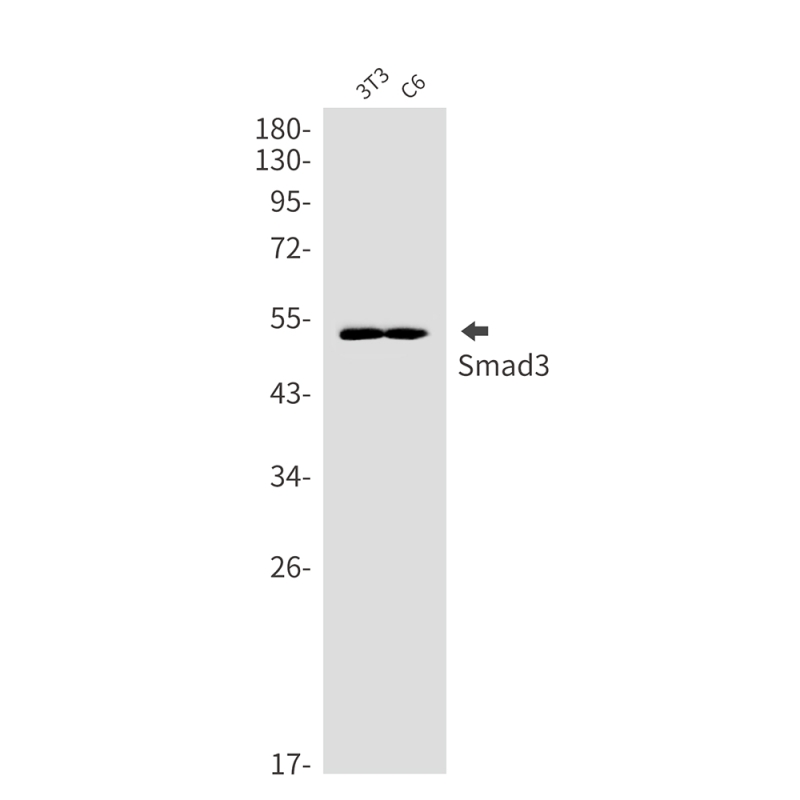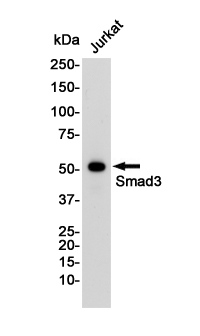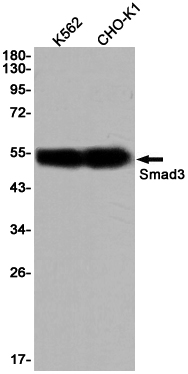


| WB | 1/500-1/1000 | Human,Mouse,Rat,Hamster |
| IF | 1/20 | Human,Mouse,Rat,Hamster |
| IHC | 咨询技术 | Human,Mouse,Rat,Hamster |
| ICC | 技术咨询 | Human,Mouse,Rat,Hamster |
| FCM | 咨询技术 | Human,Mouse,Rat,Hamster |
| Elisa | 咨询技术 | Human,Mouse,Rat,Hamster |
| Aliases | SMAD3; MADH3; Mothers against decapentaplegic homolog 3; MAD homolog 3; Mad3; Mothers against DPP homolog 3; hMAD-3; JV15-2; SMAD family member 3; SMAD 3; Smad3; hSMAD3 |
| Entrez GeneID | 4088 |
| WB Predicted band size | Calculated MW: 48 kDa; Observed MW: 52 kDa |
| Host/Isotype | Rabbit IgG |
| Antibody Type | Primary antibody |
| Storage | Store at 4°C short term. Aliquot and store at -20°C long term. Avoid freeze/thaw cycles. |
| Species Reactivity | Human,Mouse,Rat,Hamster |
| Immunogen | Recombinant protein of human Smad3 |
| Formulation | Purified antibody in TBS with 0.05% sodium azide,0.05%BSA and 50% glycerol. |
+ +
以下是3篇关于Smad3抗体的代表性文献概要:
1. **文献名称**: "Smad3: A Key Player in Pathogenetic Mechanisms of TGF-β in Fibrosis"
**作者**: Roberts AB, et al.
**摘要**: 该研究验证了多种Smad3抗体的特异性,发现其可识别TGF-β信号激活后磷酸化的Smad3(p-Smad3)。通过免疫沉淀和Western blot证实抗体在肾纤维化模型中的有效性,并揭示Smad3磷酸化与胶原沉积的正相关性。
2. **文献名称**: "Antibody Specificity Analysis in Smad3 Knockout Mouse Models"
**作者**: Datto MB, et al.
**摘要**: 利用Smad3基因敲除小鼠组织,系统验证了三种商业化Smad3抗体的交叉反应性。发现部分抗体与Smad2存在非特异性结合,提出通过C端特异性抗体可提高检测准确性,为抗体选择提供了实验依据。
3. **文献名称**: "Phospho-Smad3 Antibody Application in Cancer Metastasis Studies"
**作者**: Yu H, et al.
**摘要**: 研究开发了针对Smad3磷酸化位点(Ser423/425)的单克隆抗体,通过免疫组化证明其在乳腺癌转移灶中的特异性标记能力,发现p-Smad3核定位与EMT过程相关,为癌症预后提供了新标志物。
**注**:如需获取完整文献,建议通过PubMed或Web of Science检索DOI号。实际研究中推荐优先选择经基因敲除验证(KO-validated)的抗体文献,并注意区分检测总蛋白或磷酸化蛋白的抗体类型。
**Background of Smad3 Antibody**
Smad3 is a critical intracellular signaling protein in the transforming growth factor-beta (TGF-β) pathway, which regulates diverse cellular processes, including proliferation, differentiation, apoptosis, and immune responses. Upon TGF-β receptor activation, Smad3 is phosphorylated, forms complexes with Smad4. and translocates to the nucleus to modulate gene expression. Dysregulation of Smad3 is implicated in fibrosis, cancer, autoimmune diseases, and tissue remodeling.
Smad3 antibodies are essential tools for studying TGF-β/Smad signaling. These antibodies are designed to detect endogenous Smad3 protein in various applications, such as Western blotting (WB), immunohistochemistry (IHC), immunoprecipitation (IP), and immunofluorescence (IF). Specific antibodies can distinguish between phosphorylated (active) and unphosphorylated Smad3. enabling researchers to analyze its activation status. Some antibodies also differentiate Smad3 from its homolog Smad2. despite their structural similarities.
The development and validation of Smad3 antibodies have advanced research in disease mechanisms. For instance, studies using Smad3-deficient models or inhibitory antibodies highlight its role in fibrosis progression and cancer metastasis. In translational research, Smad3 expression levels or phosphorylation status may serve as biomarkers for disease prognosis or therapeutic targeting. However, antibody specificity and cross-reactivity require careful validation using knockout controls or peptide-blocking assays to ensure accurate experimental outcomes. Overall, Smad3 antibodies remain indispensable for unraveling TGF-β-related pathologies and developing targeted therapies.
×